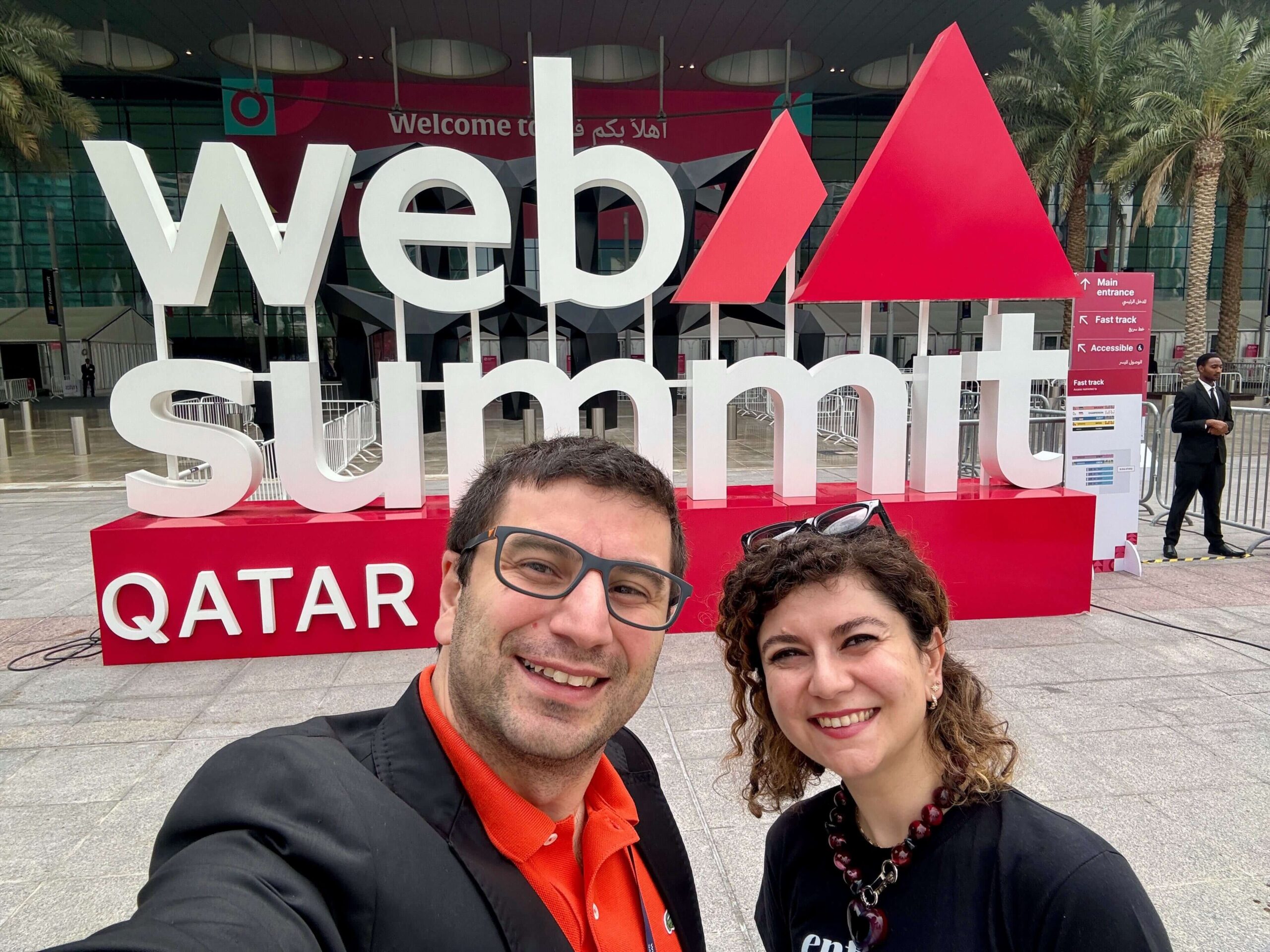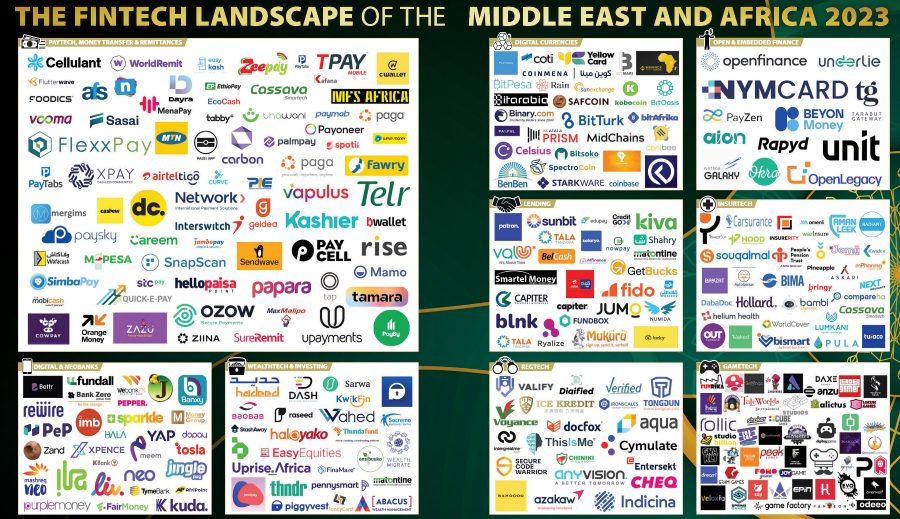
Entrapeer’s back from Web Summit Qatar! Despite the long plane rides and lingering jet lag, we’re feeling more inspired than ever. After all, we just spent four days brushing elbows with some of the MENA region’s most innovative startups and forward-thinking governmental institutions.
But last week wasn’t just big for entrapeer – the conference marked a significant milestone as Web Summit Events opened their doors for the first time in the Middle East.
The event was a smashing success with over 15,000 attendees and over 1,000 startups. It was also a testament to Qatar’s growing prominence as a focal point for international trade and economic development. The region’s young population, digital penetration, and burgeoning startup scene – thanks in no small part to strong governmental support for the sector – make MENA especially attractive for investors.
Entrapeer was honored to attend this debut, and even exhibit in the Startups’ BETA program. We were overjoyed with our positive reception by governmental institutions, global thought leaders, and pioneers in corporate innovation.
We were especially keen to understand regional developments in finance, automotive, and renewable energy. This blog dives deep into the trends in each of these three sectors, the challenges that lie ahead, and how you can leverage the insights from our WSQ Event Digest to make your post-conference lead follow-up as targeted and impactful as possible.
But first, let’s take a closer look at what this conference means for the MENA region’s startup landscape.
Web Summit Events Comes to Qatar

Web Summit Events has cemented its reputation as one of the most influential tech conference organizers in the world. Which is exactly why Web Summit Qatar marks a pivotal moment for the MENA region.
By hosting this summit, Qatar showcases its commitment to a sustainable future and digital transformation under the National Vision 2030. With government backing and the involvement of key public figures, the event fosters a dialogue on policy, technology’s potential in governance, and the strategic role of emerging technologies like AI and blockchain. The summit event not only provides a platform for dialogue but also catalyzes regional tech ecosystem growth.
Policy and Government Engagement
Under its National Vision 2030, Qatar is unparalleled in its infrastructure and sustainability efforts, making it an ideal host. The Doha Exhibition and Convention Center boasts state-of-the-art facilities, aligning with the summit’s ethos of innovation. Government support, notably from the Minister of Communications and Information Technology and the Government Communications Office, showcases Qatar’s commitment to technology and development.
Thus it comes as no surprise that engagement with policy and the public sector stands as a cornerstone of the summit. With active participation from government entities, including Sheikh Jassim bin Mansour Al Thani, the event shapes public discourse and policymaking in technology. Discussions also extend to the roles of AI and blockchain in achieving efficient governance, shining light on Qatar’s forward-thinking government strategy.
Our focus remains astute on technology’s role in transforming local industries, emphasizing renewable energy and sustainability in the automotive sector. International companies and startups presenting at the summit events will collaborate with MENA region entrepreneurs, leveraging networking opportunities to bolster the local tech scene and diversify beyond traditional industries, such as oil and tourism. This transformation is epitomized by the state’s aspirations for economic development, particularly in tech innovation.
Finance in the Middle East

Before we delve into the complexities of finance within the Middle East, it is crucial to acknowledge the region’s dynamic investment landscape, the swift digitization of its finance sector, and the ongoing challenges faced in privatization. In this section, we explore the evolving synergy between government and the private sector, as well as how Middle Eastern markets are extending their reach globally.
Investment Landscape
The Middle East’s investment landscape is dynamically evolving, especially in the fintech sector, where a surge in activities from industry leaders and investors is evident. With the backing of substantial government support, the region has become a fertile ground for fintech startups, notably in the realms of fintech super apps, and Buy Now, Pay Later (BNPL) platforms.
Companies like YAP from the UAE, MNT-Halan from Egypt, and Tamara from KSA are leading examples of enterprises that have secured significant funding, demonstrating the region’s commitment to fostering a robust startup ecosystem and solidifying its position in the global tech arena.
Digitalization of the Finance Sector in the Middle East
Digitalization is reshaping the finance sector in the Middle East, with innovative technology solutions revolutionizing services and offering new avenues for development. The surge in Buy Now, Pay Later (BNPL) platforms, payment solutions for merchants and SMBs, cross-border payments, and open banking are significant trends.
Startups like Lamaa, Foodics, Paymob, and Hubpay are among those receiving the largest funding, indicating the rapid pace at which the sector is adopting digital solutions. The regulatory environment, particularly in countries like Bahrain, is adapting to these changes, further propelling the MENA region to the forefront of the global finance sector.
Challenges of Privatization, Accounting, and Budgeting
Despite rapid growth, the Middle East faces challenges in privatization, accounting, and budgeting within the fintech sector. Balancing innovation with regulation, protecting investor interests, and maintaining transparent financial practices are critical for the sector’s sustainability and integrity. This delicate balance underscores the importance of fostering environments conducive to business and technological innovation through policy reform and incentives.

Government and Private Sector Synergy
There is a notable synergy between the government and the private sector in the Middle East, with both recognizing the mutual benefits of collaboration. Through policy reform and incentives, governments are increasingly creating environments conducive to innovation, leveraging fintech to drive economic diversification and address climate challenges. The collaboration is crucial in advancing innovative climate solutions, given the limited climate finance coming into the region and the pivotal role of startups in building and scaling climate tech solutions.
Middle Eastern Markets and Global Outreach
Middle Eastern markets are thriving, not just locally but also in their global outreach. International entrepreneurs are drawn to the MENA region’s ripe opportunities, and existing firms are exploring cross-border partnerships.
This global integration is a testament to the region’s ambition and potential as a key player in the international finance arena, underpinned by strong government and regulator support driving fintech growth, including initiatives like regulatory sandboxes and fintech sandboxes in places like the UAE, Bahrain, and Saudi Arabia.
As the Middle East’s finance sector transforms with digital innovation and government-private collaborations, the region stands at the forefront of global fintech. Despite facing privatization and regulatory challenges, strategic investments in startups and digital solutions signal a commitment to maintaining a dynamic ecosystem. The synergy between government initiatives and private sector ingenuity is crucial for navigating future challenges, showcasing the Middle East’s potential as a major player in the international finance landscape.
Sustainability in Automotive
The MENA region, much like the rest of the world, is facing environmental challenges such as air pollution and climate change. Unlike the rest of the world, however, many MENA countries are major oil producers.
Their move towards electric vehicles and more sustainable sources positions these countries as global thought leaders, reduces their dependency on oil, and develops renewable energy sectors, aligning with global sustainability goals. This transition integrates innovative technologies and involves both public and private entities to revamp transportation into an eco-friendly future.
Sustainable Manufacturing Practices
With an acute awareness of their environmental impact, automotive enterprises in the MENA region are embracing sustainable manufacturing practices. These practices include leveraging recycled materials and aiming for zero-emission production facilities, thereby reducing waste, conserving energy, and minimizing water use. Such initiatives reflect the industry’s holistic approach to contributing to environmental health and sustainability.
Public and Private Transportation Initiatives
Sustainability in transportation is a collaborative endeavor in the MENA region, with public and private sectors playing integral roles. Governments across the region are endorsing sustainable transport through incentives and legislation, alongside significant investments in public transportation systems that utilize clean energy. Morocco’s automotive developments and Egypt’s partnership with China’s Dongfeng Motor Corp. to manufacture electric vehicles illustrate the synergy between automotive industries and policymakers in transforming urban landscapes into examplars of sustainability and efficiency.
Innovation in Electric Vehicle Technology
Innovation in electric vehicle technology is pivotal to sustainability efforts, with enterprises like Qatar’s initiative to create a comprehensive network of electric car chargers leading the charge. For instance, Saudi Arabia, as part of its Vision 2030, is expanding its EV charging infrastructure through partnerships between Schneider Electric Saudi Arabia and IHCC, indicating a robust commitment to enhancing battery technologies and energy management systems for EVs. These advancements, including solid-state batteries, are being developed to offer longer ranges and quicker charging times, addressing scalability and cost challenges to make sustainable transport more accessible.
Energy Transition Strategies
The automotive sector in the MENA region is vigorously adopting energy transition strategies, significantly investing in renewable energy infrastructure to support EV integration. The UAE, for example, is leading in EV adoption, showcasing an extensive network of charging stations as well as incentives like tax breaks, subsidies, and free parking to meet their ambitious target for 30% of all new vehicles to be EVs by 2030. This effort aligns with creating a seamless charging network and fortifying the electric grid to accommodate the rising demand from EVs, embodying the region’s dedication to achieving long-term sustainability objectives.
These initiatives underscore a concerted effort by enterprises and government organizations in the MENA region to promote sustainability in the automotive sector, from innovative EV technologies and energy transition strategies to sustainable manufacturing and comprehensive transportation initiatives.
Renewable Energy: A Global and Local Perspective
As we explore the landscape of renewable energy, we note its pivotal role in meeting global sustainability targets and fueling economic growth through innovative technologies. Our approach is geared toward understanding how these technologies are adopted, the progression of sustainability initiatives, the investments driving energy infrastructures, and the collaborative efforts with leading energy corporations.
Sustainability Goals and Initiatives
Underpinning these technological advancements are Qatar’s broader sustainability goals. The National Climate Change Plan, approved in September 2021, sets out over 300 adaptation initiatives focused on mitigation, aiming to tackle climate change by diversifying the economy and optimizing natural resource use. This plan is closely aligned with the UN Sustainable Development Goals and includes measures to enhance climate resilience. Qatar’s efforts also extend to building sustainable cities, like Lusail City and Msheireb Downtown, which incorporate green technologies and optimized urban planning to reduce carbon emissions and improve environmental stewardship.
Collaboration with Energy Corporations
Corporate collaboration is key to Qatar’s renewable energy strategy. For instance, QatarEnergy’s updated Sustainability Strategy emphasizes reducing greenhouse gas emissions by 25% by 2030 and deploying Carbon Capture and Storage (CCS) technologies. Additionally, QatarEnergy has signed agreements with Shell and Korea’s Hydrogen Convergence Alliance for cooperation in hydrogen energy, showcasing the nation’s approach to integrating renewable energy solutions through strategic partnerships.
Investment in Energy Infrastructure
To support these ambitions, Qatar is investing heavily in energy infrastructure, with significant projects like the Mesaieed and Ras Laffan solar plants, which have a combined capacity of 880 MW and are slated to be operational by the end of 2024. These investments reflect the importance of robust infrastructure in supporting the growth of renewable energy sources, demonstrating Qatar’s commitment to transitioning towards a more sustainable energy mix.
Adoption of Renewable Technologies
As we touched on above, Qatar is making significant strides in adopting renewable technologies, aligning with the Qatar National Vision 2030. The country has set ambitious targets to develop a low-carbon energy sector, reduce emissions, and maintain its leadership in the LNG sector.
One notable project is the Al Kharsaah Solar PV Power Plant, which, with its 1.8 million solar panels, aims to generate around 2 TWh of electricity annually. This initiative is part of a broader commitment to install 2-4 GW of solar power nationwide by 2030, highlighting Qatar’s dedication to reducing reliance on fossil fuels through strategic investments in solar and potentially wind energy projects.
Qatar’s comprehensive approach to adopting renewable technologies, achieving sustainability goals, investing in energy infrastructure, and collaborating with global energy corporations promises a bright future ahead. Through these efforts, Qatar aims not only to meet its own sustainability targets but also to contribute to global environmental goals.
Challenges and Opportunities Ahead
While ripe with opportunities for corporate innovation and startup-enterprise partnerships, the MENA region confronts various challenges that influence its economic and innovation landscape. These challenges—ranging from economic and regulatory hurdles to the need for a skilled workforce, compliance with international standards, and adaptation to a rapidly changing technological landscape—each play a significant role in shaping the region’s approach to innovation.
Economic and Regulatory Challenges
Economic fluctuations, particularly volatile oil prices and geopolitical shifts, significantly impact the Middle Eastern market’s stability and predictability, affecting investment and innovation. Additionally, the region’s diverse regulatory frameworks, which often diverge markedly from Western norms, present unique challenges for businesses. This complexity can hinder startups and enterprises aiming to collaborate or operate across borders within the region, as they navigate varying legal and business environments.
Need for a Skilled Workforce
The demand for a highly-skilled workforce proficient in the latest technological advancements and business practices is acute. In sectors like finance, where the MENA region is witnessing a fintech revolution, there is a dire need for professionals who can meld traditional business acumen with cutting-edge fintech solutions. This necessitates robust educational and training programs to equip local talent with the requisite skills for innovation and for fostering productive startup-enterprise partnerships.

Compliance with International Standards
As MENA countries integrate more closely with global markets, adhering to international standards becomes increasingly critical. This compliance spans a broad spectrum, from financial regulations to environmental policies. In the automotive sector, for instance, sustainability standards are becoming more rigorous. Meeting these international benchmarks is crucial not only for operational alignment but also for maintaining competitiveness on the global stage.
Adaptation to a rapidly changing technological landscape
The pace at which technology evolves poses its own set of challenges. Keeping abreast of advancements, from renewable energy technologies to the latest digital platforms, requires a culture of continuous learning and adaptability within organizations (not to mention, a little help from our trend prediction engine). This rapid technological evolution demands that businesses, especially startups and established enterprises looking to collaborate, remain flexible and forward-thinking to capitalize on emerging opportunities.
In conclusion, while the MENA region offers fertile ground for innovation and the growth of startup-enterprise partnerships, navigating its economic, regulatory, workforce, compliance, and technological challenges is essential. Addressing these issues effectively can unlock the immense potential for innovation and economic growth in the region, driving forward not only local but also global advancements in various sectors.
Navigating the New Horizon: Qatar’s $100 Million Bet on Tech Innovation
In the vibrant MENA region, finance, automotive, and energy startups stand at the cusp of transformative change, propelled by unprecedented governmental support.
The finance sector, with its rapid adoption of fintech solutions like BNPL and digital payments, is reshaping consumer experiences and business models. The automotive industry’s pivot towards electric vehicles and sustainability reflects a regional commitment to reducing carbon emissions and embracing clean energy. Meanwhile, the energy sector’s shift towards renewable technologies such as solar power and wind energy underscores a strategic move away from fossil fuel dependency, aligning with global sustainability goals.
Entrapeer is excited to monitor the region as these sectors progress, especially in light of Qatar’s announcement of its startup investment program. The fund promises a hefty $100 million to be distributed across over 15 key sectors, signaling Qatar’s ambition to become a global tech beacon. It’s a vision shared across MENA, with similar initiatives like UAE’s Alpha Wave Global enriching the ecosystem.
Our presence at WSQ underscores our commitment to making innovation accessible to everyone, everywhere. We are honored to have witnessed Web Summit Events’ debut in Qatar, and already looking forward to next year.
Ready to unlock new business opportunities in the MENA region?
Sign up for a free account and explore the entrapeer platform to learn about the conference attendees, their groundbreaking use cases, trends in the region, and much more.
Our WSQ event digest provides deep insights into the dynamic landscape of corporate innovation in the MENA region and the opportunities it presents for sustainable growth and development.

